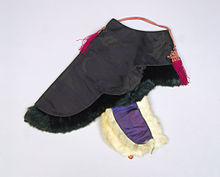A pungcha (Korean: 풍차) is a type of traditional Korean winter hat worn by both men and women during the Joseon period for protection against the cold. It is also called pungchae and jeongpungcha. Although its shape is very similar with nambawi, the pungcha has a bolkki (볼끼) attached on both sides of the ears. It was originally worn by males of yangban, the upper class but became to spread to commoners including women.[1][2]
| Pungcha | |
 | |
| Korean name | |
|---|---|
| Hangul | 풍차, 풍채, 정풍차 |
| Hanja | 風遮 |
| Revised Romanization | pungcha, pungchae, jeongpungcha |
| McCune–Reischauer | p'ungch'a, p'ungch'ae, chŏngp'ungch'a |
The pungcha is open on the top so that it does not cover the top of the head just like other winter caps such as nambawi, ayam, and jobawi. Whereas it fully covers the forehead, back and ears on the sides as well as cheeks by the bokki. The outer is generally made of a variety of silk called dan (단, 緞), wool and a fabric made from kudzu barks were used.[1][2]
See also
editReferences
edit- ^ a b 모/남성용 풍차 (in Korean). KOCCA / Chung-Ang University. Archived from the original on 2011-10-05. Retrieved 2008-09-23.
- ^ a b 풍차(風遮) (in Korean). National Folk Museum of Korea. Retrieved 2008-09-23.
- 영남대학교 신라가야 문화연구소 (1972). Korean hats and crowns (한국의 관모) (in Korean).
- Baek Yeong-ja (백영자) (1996). Korean Costume (한국의 복식) (in Korean). Gyeongchunsa (경춘사).
- Yu Hui-gyeong (유희경, 柳喜卿); Kim Mun-ja (김문자) (1998). Cultural History of Korean Costume (한국복식문화사) (in Korean). Gyomunsa.